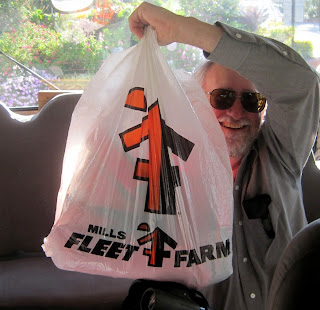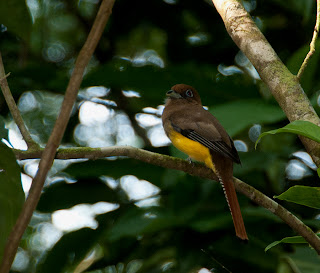 |
| 2013 Costa Rica tour group photo at Rancho Naturalista |
 |
| Long-billed Hermit nest fortified with spider webs |
 |
| Strawberry Poison Dart Frog |
 |
| Green-and-black ("Harlequin") Poison Dart Frog |
 |
| Red-lored Parrot |
About twenty minutes past the city of Limón, Didier swung off the road in the small town of Río Blanco and drove up to “Brisas de la Jungla” (The Jungle Breeze), a relatively new ecotourism facility tucked into a secondary jungle environment.
After a brief stop at the park office, Didier continued to drive us up a more narrow road toward Rancho Mirador, a summit offering views of the Caribbean coast. Clearly, zip lining was an active component of Brisas with zip lines everywhere. At the summit we found a cool breeze and discovered more poison dart frogs. We couldn’t recall any other trip to Costa Rica when we’ve found so many of these colorful jewels. As we cooled our heels at the summit, a Double-toothed Kite made an appearance giving us long looks (as well as good looks at the bird).
 |
| Central American Pygmy-Owl |
 |
| Brisas restaurant |
 |
| hiking part way down from Rancho Mirador |
 |
| 3-Toed Sloth |
 |
| road to Rancho |
Notable bird ticks on the day included: Swallow-tailed Kite, White-tailed Kite, Gray-necked Wood-Rail (heard only), Pale-vented Pigeon, Gartered Trogon, Olive-throated Parakeet, Northern Barred Woodcreeper, Ochre-bellied Flycatcher, Black-headed Tody-Flycatcher, Yellow-margined Flycatcher, Scissor-tailed Flycatcher, Stripe-breasted Wren, Plain-colored Tanager, Grayish Saltator, Melodious Blackbird, Montezuma Oropendula, and Yellow-crowned Euphonia.
 |
| Rancho Naturalista Hide |
 |
| female Red-throated Ant-Tanager |
 |
| 2nd story observation deck/commons area |
 |
| Violet-crowned Woodnymph |
 |
| breakfast below the observation deck - binoculars required |
 |
| Rancho feeding stations |
 |
| morning hike and White-capped Manakin |
 |
| Crimson-collared Tanager |
 |
| Anita at hummingbird pools overlook |
 |
| Casque-headed Lizard found lurking quietly along a trail |
Several in our group had rooms on the second level of the main lodge while a few were sequestered in small set of lovely nearby casitas. The second story central balcony was a “commons” area shared by all guests. This was where coffee and hot water for tea and some light snacks were found daily beginning at 5:00 a.m., a time most agreeable for any serious birders. Nothing like a strong cup of Costa Rican coffee to start the day.
 |
| our room at Rancho - big enough to hold a dance! |
 |
| negotiating trail at Cerro Silencio |
 |
| birding a bit slow? there were always other distractions |
Back to the lodge for a bite to eat then back on the bus to visit a section of the Río La Mina, a shallow rock-strewn fast-moving river with banks dappled in alternating sun and shadow; just the perfect habitat for another of our long sought after life birds.
 |
| Carol, "Quick! One just went 'round the bend!" |
 |
| Sunbittern |
We followed the bird as it perched/patrolled on rocks in the stream feeding on small insects and watched in awe when it spread its wings for short flights to other rocks. Definitely a trip highlight for many.
 |
| listen for a crake then find the Limpkins and Snail Kites |
By this time in the day the temperature had risen. We found it quite warm to be standing out in full sun. However, for our discomfort we were rewarded with views of Muscovy Duck, various wading birds (herons and egrets) plus a few unexpected birds (at least to us - Richard already knew they might be there). First there were Limpkin and then a few Snail Kites appeared. Both birds indicative of a local and healthy apple snail population, the single dietary mainstay of both species.
 |
| Red-breasted Blackbird |
 |
| Didier always pampering the bus; Didier with "Oso", Rancho's guard dog |
 |
| Carol and Chef Vinicio |
 |
| Lisa and Mario, Rancho managers |
 |
| Turrialba Volcano signs of activity |
 |
| church ruins |
 |
| Ujarrás grounds |
We motored on a bit further to Jardin Botánico Lankester outside of Cartago. Just down the road from the garden parking area Richard had Didier stop the bus. Richard stepped out, played a bird call recording and a very cooperate White-throated Flycatcher suddenly popped up nearby. Most everyone simply stayed on the bus as the bird continued to sit up prominently for all to see!
Lankester Botanical Gardens definitely had a birding connection. Charles H. Lankester, an amateur British botanist who in the 1940’s in cooperation with prominent orchidologists, created a private garden on his farm. In 1973 the farm were transformed into a botanical garden which has become one of the most active and important botanical institutions in the Neotropics. The birding connection? Lankester’s daughter married one of Costa Rica’s most notable ornithologists: Dr. Alexander Skutch.
Following an outdoor picnic consisting of the one and only box lunch of the entire tour (prepared at Rancho) we birded our way through parts of the garden’s extensive botanical exhibits. However, the main attraction remained the native and exotic orchids on display in the main building. Of particular interest was a massive collection of miniature orchids visible only with a handheld magnifying glass. Some of these species were so small that they relied upon mosquitoes to serve as pollinators.
Having beaten the majority of San Jose’s rush hour madness we had time to relax and again walk about the hotel grounds. Back for one last happy hour in the HB bar then it was our farewell dinner in the HB dining room. Fortunately Didier was able to attend and in fact, we found out that he would be transporting those of us who had very early morning flights to the airport.
An interesting sidebar about Didier and his tour bus. We learned that Didier is an independent contract driver who worked for Louís who owns the tour bus company we use on all our Costa Rica trips. Louís has also been the driver on two of our earlier CR trips. Didier, now an independent contractor still working through Louís, now owns the bus we were on having purchased it from another driver, Memo. Memo was the the driver on our first Costa Rica tour in 2004 (the famous tour where we were the first guests ever to arrive at the Río Tigre Lodge in the Osa Penisula by forging the Río Tigre on a tour bus). So. Didier's bus was the same bus we were on in 2004! No wonder it felt so familiar!
It was a marvelous carte blanc meal giving everyone an opportunity to recount their individual trip highlights. Of course most of the trip would not have been possible were it not for Richard’s unfailing ability to pull together another intriguing itinerary as he has on all our other CR adventures with him. His professional guiding was impeccable. And as usual, his handling of all the small and not so small trip details each day allowed us all to fully enjoy Costa Rica with few of the worries of traveling in a foreign land.
Oh, yes. And a few more notable species added on our last day included: Least Grebe, Wood Stork, Smokey-brown Woodpecker, Crimson-fronted Parakeet, Brown-headed Parrot, Plain Wren, and Rufous-capped Warbler.
The alarm clock went off far too early the next morning. While most of the group was still in bed a handful of us were driven to the airport which, incidentally, had a major makeover since our last visit. Just after sunrise we were on board winging our way back to Atlanta. Unfortunately, our flight included a very, very long Atlanta layover so we didn’t get back to Austin until early evening. As promised, Kate and Dennis gathered us from the airport and once again put us up for the night. After lavishing us with breakfast and an invitation to stay longer, we felt the need get back and open up the RV so we hit the road back to the Rio Grande Valley.
All in all another grand Costa Rica adventure. Bird-wise it was not a trip designed for high numbers but we still managed to add more life birds and break our 600 species mark for our overall country list. Trip total of seen/heard birds came to 309 species. Plus, we got to experience three new lodges.
If you’re planning a trip to Costa Rica by all means please consider Richard. Visit his Gone Birding Tours website for contact information. And even if you don’t rely on Richard you’ll surely need to acquire his critically acclaimed field guide (updated edition soon to be released). When will we be back again to Costa Rica? You never know. In the meantime we’re already gearing up for our 2014 return trip to Ecuador. Pura Vida!
 |
| Richard and his wife |
 |
| Todd and Cindy |
 |
| Malachite Lizard |
 |
| Spectacled Owl |
 |
| Greg's haute corture |
 |
| why is it called a "funny bone" when there's nothing funny about it! |
 |
| Black-headed Trogon, female |
 |
| interesting park regulation lower right hand corner |
 |
| Kevin Easley in power bird guide pose |
 |
| Lynn busnapping |
 |
| Marge and Tom |
 |
| Mawamba Lodge boat tour environment |
 |
| Montezuma Oropendola colony |
 |
| spider monkey sipping water trapped in a bromeliad |
 |
| Vicki napping |
 |
| Rufous-naped Wren nest construction |


























I loved those hammocks!!! Easy to get into...another story getting out of..especially after several rum & cokes. Great job Tom!
ReplyDeleteVicki